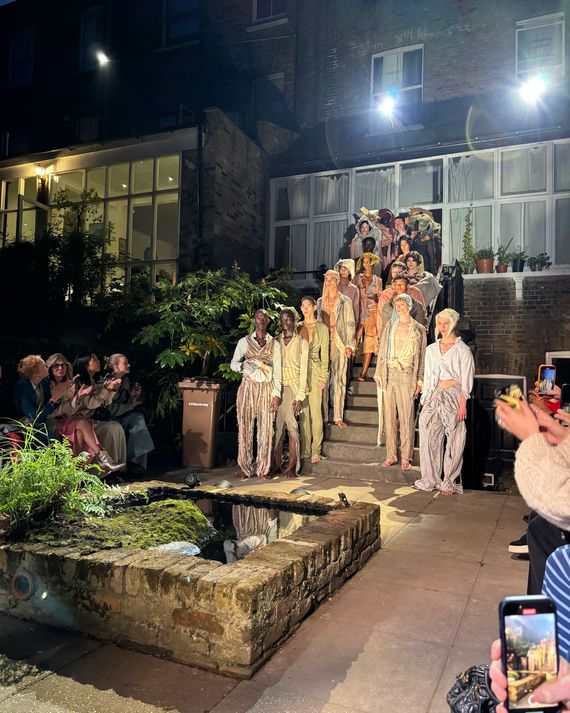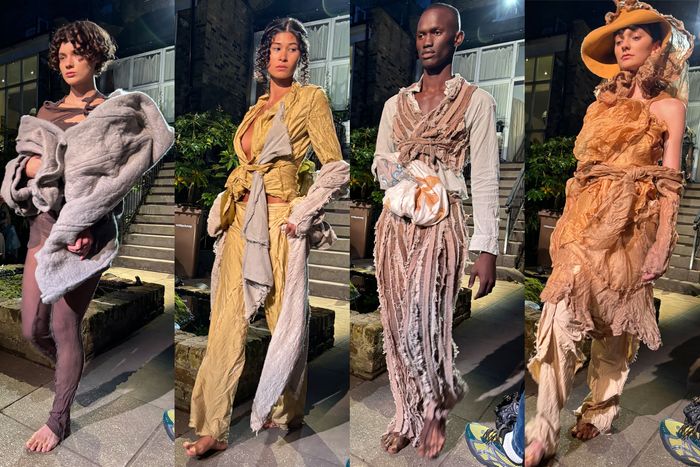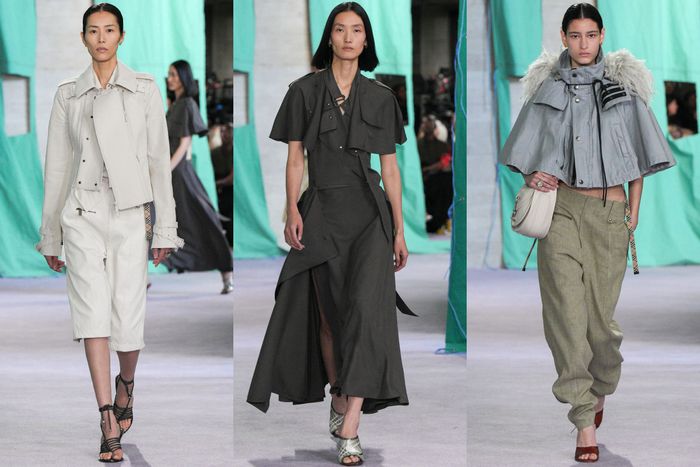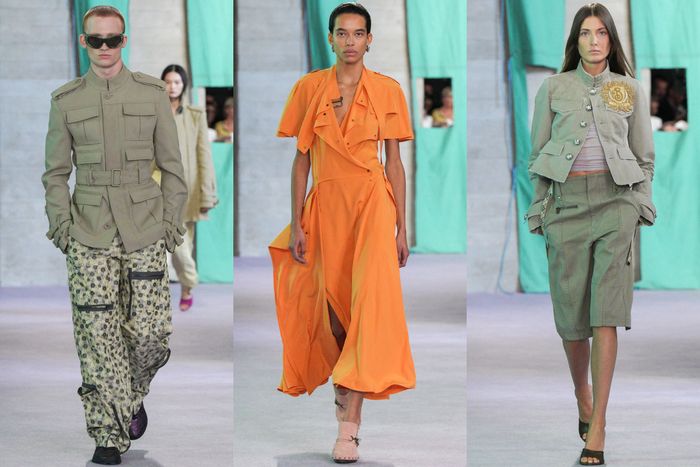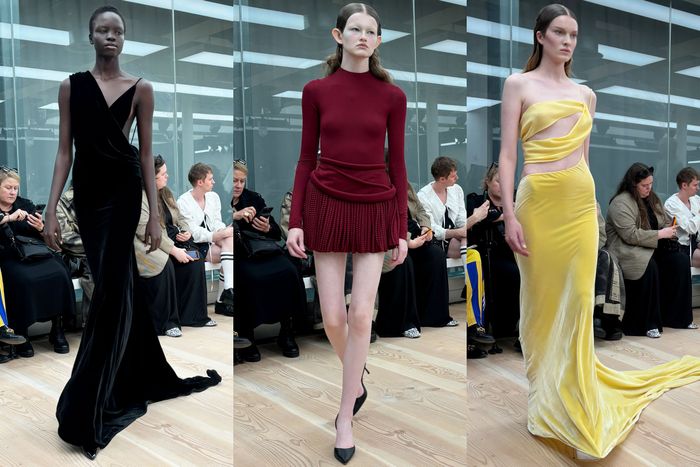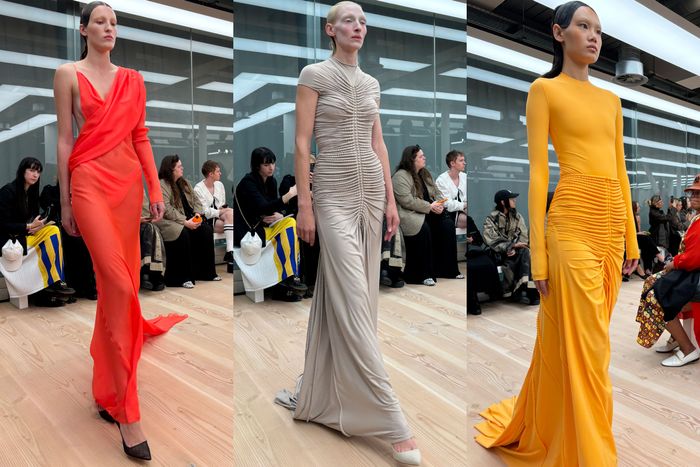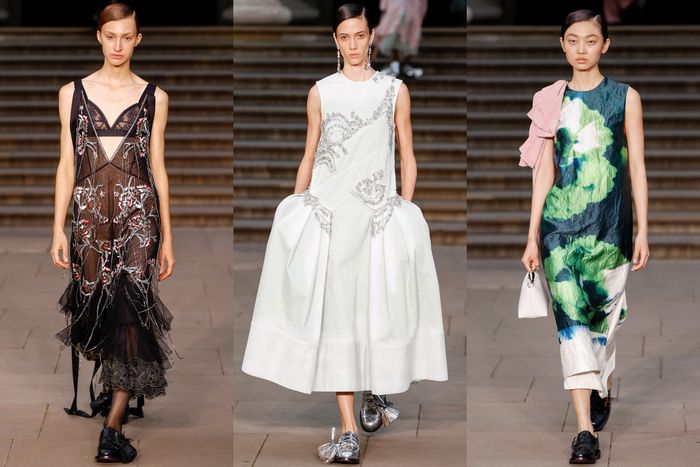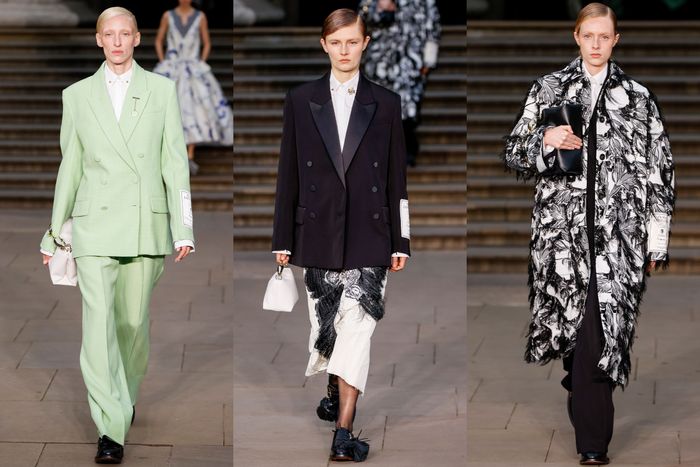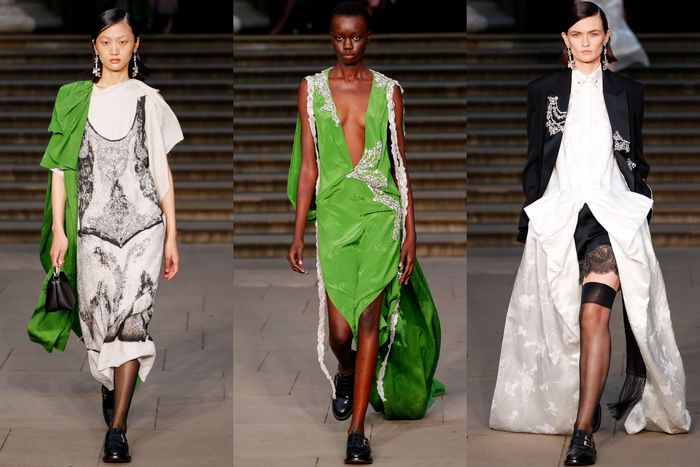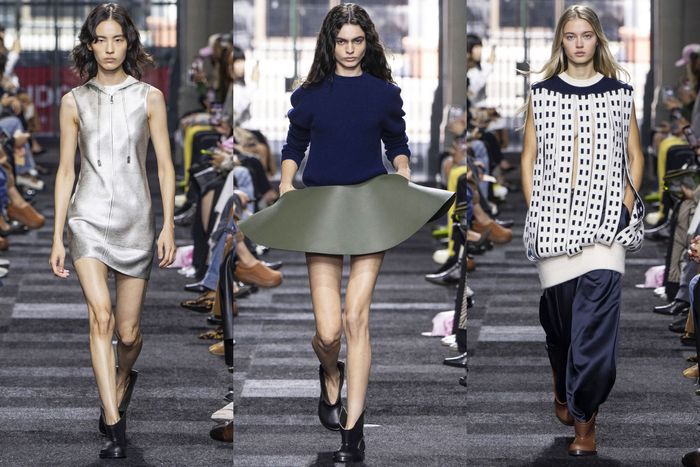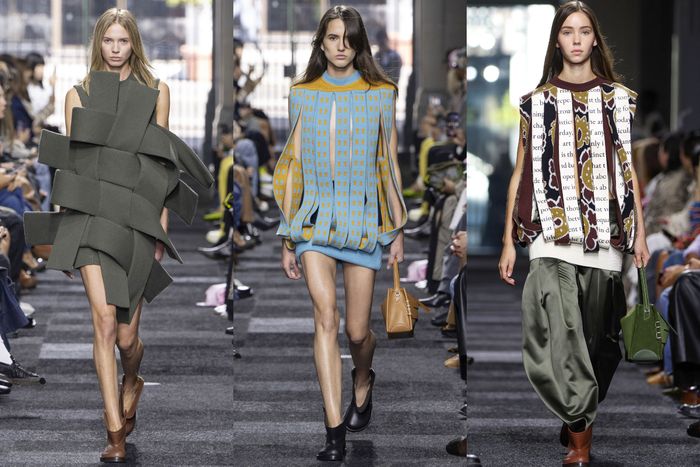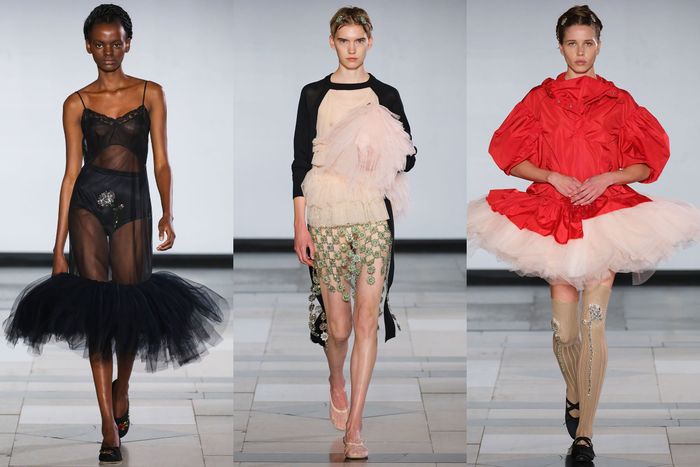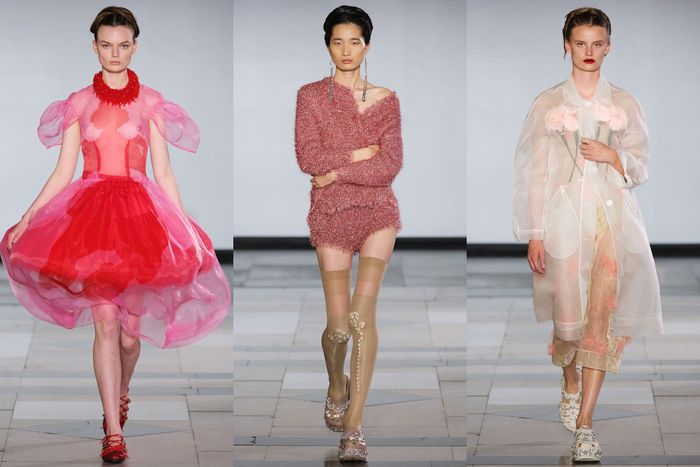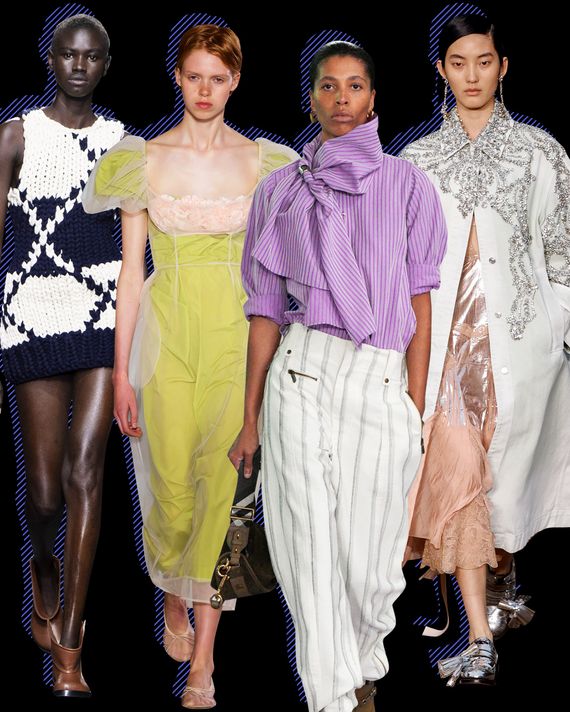
Photo-Illustration: by The Cut; Photos: Getty Images, Courtesy of Simone Rocha, Courtesy of Burberry
The London spring shows ended miles apart on Monday — in tone, scale, and imagination — with King Burberry taking over the monumental lobby of the National Theatre and a young Welshman of Italian descent, Paolo Carzana, holding his strange and obsessive collection in the garden of his East End home. The hair and makeup team used the local pub to prepare Carzana’s models. That naif-rebel spirit is still alive in London, though harder to discover in the noise. “I feel so out of place with this idea of coolness — just everything,” said Carzana, standing in the twilight after his stirring show as guests spilled out onto the sidewalk and surrounded him. “I feel so disconnected from everything. I just care about the clothes and the making.”
Photo: Cathy Horyn
Photo: Cathy Horyn
Carzana, a finalist for this year’s LVMH Prize, uses plants and natural pigments like burnt umber to dye his garments; their flat colors are taken in part from clouds and in part from the artwork of Henri de Toulouse-Lautrec, who died in 1901 at age 36. Carzana’s clothes look poor and raggedy, but look closer and some could be a palimpsest of the attire of Lautrec’s adored dancers and streetwalkers, in line and texture. The pinstripes on a pair of men’s trousers looked blurred, picked to a raw fuzziness. To me, Carzana is a defiant kink in the fashion system. His work continues to absorb me for its absolute integrity, and because no designer sees beauty and strength the way he does. I would love to see someone wear his clothes through Piccadilly.
Meanwhile, Daniel Lee, the creative director of Burberry, and the brand’s new chief executive, Joshua Schulman, who started two months ago, are trying to pick up the threads of Britain’s most famous fashion name and reclaim the allure and power of a more than decade ago, when it was designed by Christopher Bailey and led by Angela Ahrendts (and before her by Rose Marie Bravo). As Lee said after his show, “Burberry in its heyday really did enjoy American CEO leadership together with a British designer, and hopefully that’s a synergy we can” get back to. Schulman, who has studied a fat research report about the brand recently conducted by an outside firm, told me that, in essence, what it needs to achieve is a tension between heritage and modernity. He recalled that when Burberry opened its largest flagship in London in 2012, it was “like an Apple Store had been dropped in the middle of Buckingham Palace.”
Photo: Courtesy of Burberry
Photo: Courtesy of Burberry
Photo: Courtesy of Burberry
Lee’s latest collection suggests that he and Schulman still have to put their heads together, at least fashion-wise — though it’s too early to expect “synergy.” Considering some of the heavy effects of his first collection, with its bright blanket plaids, Lee has lightened things up. Colors are more muted. There’s a crisp army-tailoring element, along with some cropped or shrunken battle jackets that sport a catchy archival crest, which were shown with soft trousers with gathered hems. Lee reprised checked pants with a zipper running the length of each leg. (Phoebe Philo also has a version.) What looked fresh and summery were striped black pants with a gray striped blouse with a big pussy bow (or a lilac shirt with striped white pants) and some of the mildly deconstructed trench coats (turned into an easy dress, for example).
But something is missing. Call it wit or a sense of surprise. I would hate to see Burberry turned into a cute and capitalistic spree of products. But I also want to be startled, maybe even charmed. It is possible.
Many designers established their names in London and have remained loyal to it, like the Irish-born Simone Rocha and Jonathan Anderson, as well as Erdem Moralioglu, born in Canada to Turkish and British parents, who started his label Erdem in London in 2005. One of the newest stars is Michael Stewart, founder of the two-year-old label Standing Ground and a winner of this year’s LVMH Prize, which came with 200,000 euros.
Photo: Cathy Horyn
Stewart’s work — custom-made dresses in solid-hued jersey and velvet, and new molded pieces in leather — has the uncompromising spirit of Azzedine Alaïa, Madame Gres, and Madeleine Vionnet. That’s nice company, and it’s not to suggest that Stewart has pirated their style. But would it matter if he did? Just as in music, nearly all fashion comes out of something: Alaïa owed a debt to Vionnet and Cristobal Balenciaga; Alexander McQueen looked at early Helmut Lang and Martin Margiela and put his own darker notes on minimalist tops and pants, redefining fashion in the ’90s. This was Stewart’s first solo show, and what came through was an ability to turn patternmaking and sewing skills into beautiful forms for the body. You can have skills but not appreciate the body. Stewart, though, respects both, and that’s why his clothes have a powerful sense of harmony. I could have watched much more.
Photo: Cathy Horyn
He seems like the older generation of couturiers in that he wants what he wants — and it isn’t necessarily a big brand. Many young designers — he’s 35 — would change their collections every season, showing us what they can do. Not Stewart. (And not Carzana either.) Stewart continues developing his draping and cutting techniques as if, well, he’s standing his ground. His embellishment is pearl beads of various sizes pushed one by one into narrow channels of layered jersey (or leather) to form rib upon rib. Or the illusion of fringe for a sublime minidress in rusty red, a Roman warrior shape that was a new twist for him. Other signature details are curving ridges of fabric. It’s no wonder that his designs evoke the remains of artifacts, although the overall effect — achieved through masterful cutting and Stewart’s eye — is modern.
Can he build a business on custom-order dresses and a few leather coats? Who knows? I’m just glad to see another London designer turning away from the brand cant of the last 20 years and staking his future on pure design. When I asked Stewart how he plans to spend his prize money, he said he will put it all back into the work. He has no debt to pay off. “I’ve been really careful.”
There’s been a fair amount of poor-mouthing again about the state of London Fashion Week, that the shows have lost their creative edge and that designers are struggling to stay afloat in a pitiless economic climate. Many of the reasons go back to the beginnings of globalization and the internet, the rise of luxury groups like Kering and LVMH, and the decline of specialty stores, indeed specialists. But it’s also true that people have complained about London fashion — lacking resources and support and losing talent to Paris — for at least four decades. Not constantly but periodically, when things are in limbo.
What I found so interesting about this season is how some of the experienced designers, including Anderson, Rocha, and Erdem (he goes by his first name) managed to pivot sharply — Rocha and Erdem away from what some might call their comfort zones.
Erdem included a wonderfully refreshing dose of masculine English tailoring. You don’t think of Erdem for suits, right? I kind of tuned out recently when he did a show around the late Duchess of Devonshire. Just too frumpy and static. This season, though, inspired by the life of Radclyffe Hall, who in 1928 published the novel of lesbian love The Well of Loneliness, Erdem showed greater range and a sense of surprise. He worked with the Savile Row tailor Edward Sexton on the opening pair of dark suits and a dinner jacket that appeared later in the show (in front of the British Museum). Other trouser suits, including one in pale pink and another in mint, were made by his studio. “It felt so nice to play with masculine structure,” he said.
Photo: Getty Images
Photo: Getty Images
Photo: Getty Images
Dresses generally followed the suits in a slim silhouette, though he also showed some drop-waist styles with soft skirts, done in washed mint-green denim embroidered in silver. As Erdem said of the denim, “It has this weird, glowing iridescence.” He created milky black-and-white floral prints on spare shifts that evoked a photographic process called cyanotype. The collection was a step forward for Erdem, though I wish he’d injected a bit of sex or irony into things and chosen a less grand venue than the museum.
“The raw material in fashion is ultimately the exciting part of what we do. It has endless ways of interpreting,” said Anderson, who held his JW Anderson show in the old Billingsgate Fish Market, now an event space. He stuck with silk, cashmere, sequins, and leather, applying different techniques to the materials. The results were simple and magical, particularly the opening mini-shifts in silk. One silvery-gray dress looked like a tight-fitting hoodie — with nearly 3-D details of the zip and hood. He put many of the looks, including chunky hand-knit shifts and clingy cashmere tops with saucer-shaped leather skirts, with cool, half-zipped booties. “I wanted something quite girlie,” he said. But also tough. By reducing the forms and materials and turning up the dial on the technique, Anderson gave us unexpected directness.
Photo: Getty Images
Photo: Getty Images
Opening with music from Nino Rota’s soundtrack for Fellini’s La Strada, Simone Rocha put on a dazzling show at the Old Bailey, the famous criminal courts building. “I wanted people to go, ‘Wow,’” the designer said later at a dinner at Claridge’s hosted by Mytheresa, the long tables decked with roses. She wanted everyone to be startled by the change in direction, toward a leaner, sexier, more stripped-back Rocha and away from romantic confections and tents. It was overdue.
Photo: Courtesy of Simone Rocha
Photo: Courtesy of Simone Rocha
Photo: Courtesy of Simone Rocha
Ballet provided a nominal theme, though even her tutus were irreverent. There were sparkly twinsets with rompers, black tailored jackets spliced open over tulle miniskirts, and sheer and papery taffeta styles hazily printed with carnations. Because she has such a rigorous set of motifs, like flowers and feminine trappings, Rocha could afford to make the change. And she’s now given herself more freedom to play.

